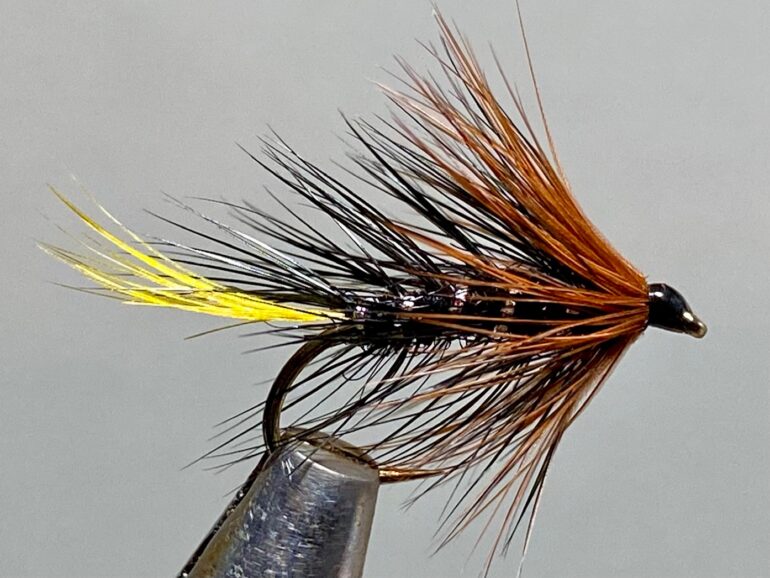
April 2022 – A Fly to Tie & Try
Apologies for the late posting of this blog and thanks to Les Lockey for doing another Monthly Fly blog for us to post here:
Fly of the Month – April
The Kate McLaren
Hook: Kamasan B170, sizes 10 to 14.
Thread: Black Semperfli Nanosilk, 50D, or any 8/0 black thread.
Tail: Golden pheasant crest feather.
Rib: Oval Silver tinsel, medium.
Body: Black seal’s fur.
Body Hackle: Black cock hackle.
Head Hackle: Red game hen hackle.
TYING
Photo 1. Secure the hook in the vice, wind on a bed of thread from the eye to just before the bend and remove the waste thread.
Photo 2. Tie in a golden pheasant crest feather on top of the shank as a tail and trim the waste end to the length of the body. Follow this by tying in the oval tinsel and again leave the waste end the same length as the body. Now bind down all the waste ends with thread and return the thread to the tail.
Photo 3. Dub some seal’s fur onto the thread and wind the dubbing up the shank to form a slightly tapered body.
Photo 4. Using well waxed thread, tie in the cock hackle by its stalk and trim off any excess stalk. Palmer the hackle by winding on 2 turns of hackle one behind the other, before continuing to wind the hackle in open spirals down the body to the tail. At this point, trap the hackle with a turn of the silver tinsel and continue to wind the tinsel in open spirals up the body and through the hackle fibres, before tying it down securely at the head. Remove the excess hackle tip, trim off the waste tinsel and tidy the head area with a few wraps of thread ready for the head hackle. If required, lightly brush the body with Velcro to tease out a few fibres into the hackle.
Photo 5. Immediately in front of the body hackle, tie in the hen hackle by its tip and remove any excess tip. Take hold of the hackle stalk and gently stroke the hackle fibres together, then wind on 3 or 4 turns of hackle moving towards the eye. Secure with thread and remove the waste hackle.
Photo 6. Tidy the head with thread, whip finish, remove the thread and varnish the head to complete the fly.
Tying Tips
- Golden pheasant crest feathers often suffer from kinks and twists, which if not too severe, can still be used by simply holding the feather by the tip when tying it in. This should push the twist into the waste part of the feather, leaving the tail straight. For badly twisted feathers, soak them in boiling water for about 30 seconds, before removing them one at a time with a pair of forceps and mould the feathers around a smooth curved surface, such as the neck of a glass bottle or metal rod and leave them to dry. When dry, the feathers will be back to their pristine best, having taken on the curve of whatever substrate they were wrapped around.
If the above is too much effort, yellow cock hackle fibres are a reasonable substitute, or for a more modern twist, try using Glo Brite floss, shade No. 11, Phosphor Yellow, or No. 12, Lime Green, or for something a little bit different, try No. 8, Amber.
- Many people find dubbing with seal’s fur a tricky task, but in most cases, this is simply down to applying too much fur onto the thread at one time. The following tips might also prove helpful.
Apply seal’s fur sparingly onto lightly waxed thread and always twist the dubbing in the same direction. Pay particular attention to the fibres closest to the shank, as after the first turn or two, these will anchor the dubbing to the shank allowing the remaining dubbing to be wound on and twisted around the thread in stages as more thread turns are made.
Baby seal’s fur is softer and less springy than adult fur which makes it much easier to use, but unfortunately, it can be quite difficult to obtain. For particularly springy adult fur, mesh the fibres together by rubbing the fur into a ball in the palm of your hand before teasing it out onto the to the thread. Alternatively, try mixing the seal’s fur with a pinch of the same coloured rabbit fur, as this helps the fibres to bind to the thread. It also helps to moisten your fingers before dubbing the fur onto the thread.
- To prepare the cock hackle, remove the waste fibres from the base of the hackle stem, and trim the stem to a length of 1-2mm. With the good side of the feather facing forward towards the eye, tie in the stem stub using 3 or 4 turns of well waxed thread. This keeps bulk to a minimum and helps in the formation of a neat head.
- When winding the rib, don’t worry about catching body hackle fibres, just bring the rib briskly through the hackle and the stiff cock hackle fibres will spring out of the way.
- I like the brown hen hackle to be slightly longer than the black body hackle as this helps maintain the tapered proportions of the fly. To prepare the hen hackle, clamp the tip of the feather in a pair of fine hackle pliers and gently stoke back all the other fibres so the tip is clearly exposed. Remove the pliers and cut off the tip to leave a small triangular stub about 1mm. in length and use this stub to tie in the hackle with well waxed thread. This avoids trimming the feather tip after it is tied in, and helps to produce a small, neat head.
- Before winding the hen hackle, “double the hackle” by holding the hackle stalk while gently stroking the fibres together. This leaves the stem as a clean leading edge with the hackle fibres pointing rearwards. Continue to stroke the fibres back as each turn of hackle is made to maintain the shape and neatness of the finished hackle.
Fishing notes
- The Kate McLaren is a classic Scottish wet fly that dates back to the 1930’s. It is widely used as a top dropper pattern, fished on a floating line for sea trout and brown trout, but it also takes its fair share of rainbows too, as can be seen by flicking through the catch returns book.
- Traditional loch style fishing is almost a dying art in today’s still water scene, which is a great shame, since on overcast days with a good breeze and the fish prepared to chase, it can be a very effective and exciting way of catching trout. A long rod is a great benefit when traditional loch styling, as it allows the flies to be retrieved simply by raising the rod tip and almost stroking the flies back towards the boat, ensuring each fly in turn, is dibbled in the wave tops, before the flies are cast out once again.
- Back in the late eighties, I remember Bill Bryce, a regular Coldingham Loch holiday angler, whose trips invariably coincided with my own, who often used traditional wet flies to great effect. One of his favourite casts was a Mallard and Claret on the point, Soldier Palmer in the middle and a Kate McLaren on the bob and it proved the downfall of many Coldingham Loch trout.
- For me, irrespective of the flies used, the middle dropper position has never been particularly successful, and although it could perhaps be argued that it might attract fish to the other flies on the cast, some years ago I decided to dispense with the middle dropper fly without any noticeable reduction in my catch rate, and with the added bonus of far fewer tangles.
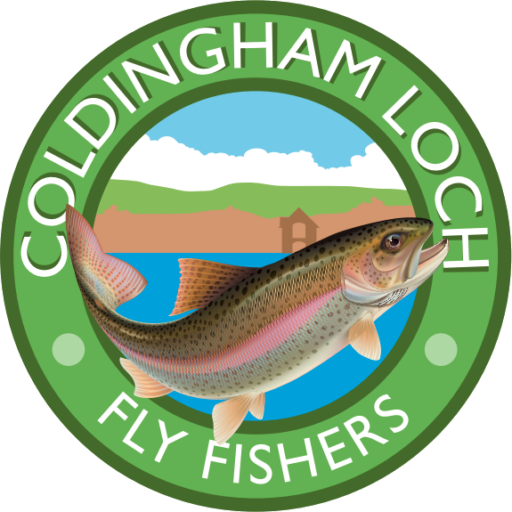

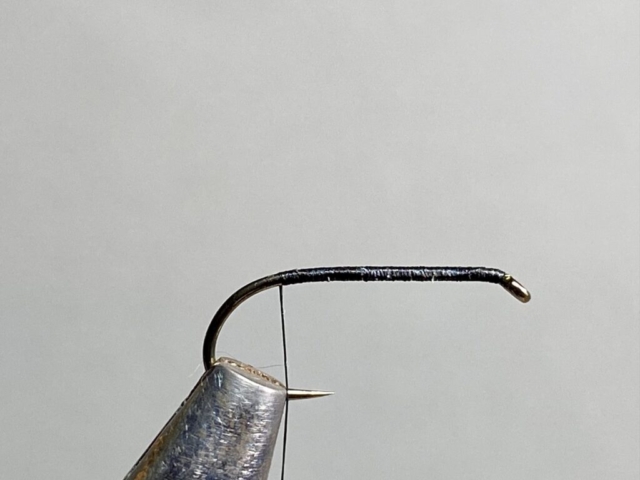
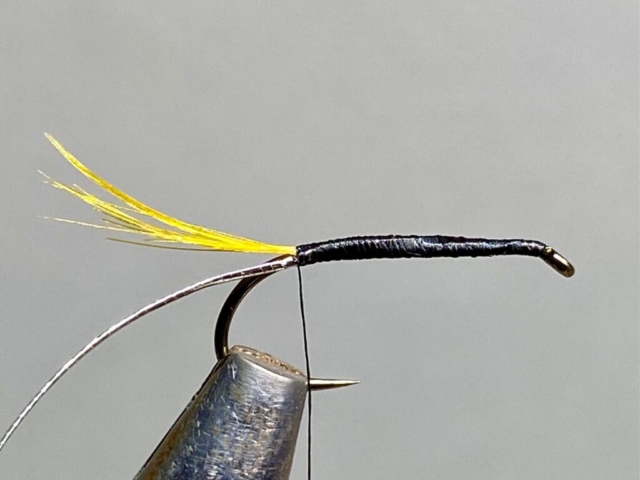
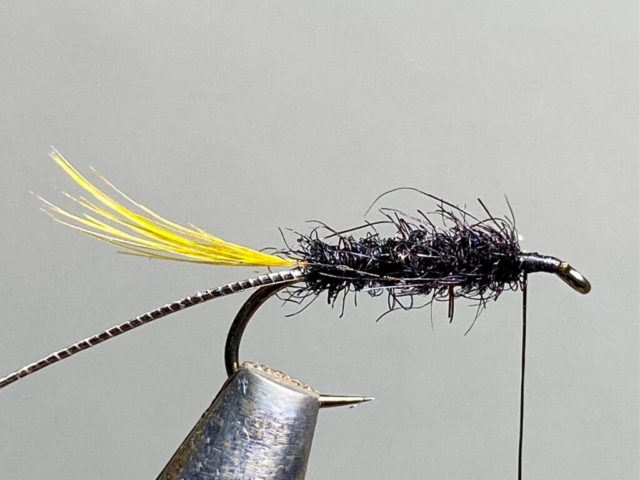

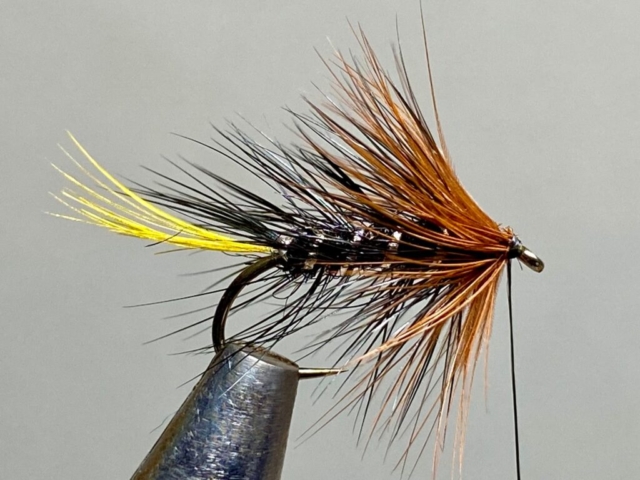


Recent Comments